





The city of Almeria was founded by the Moors, and the city's atmosphere and older architecture certainly reflects that. The Alcazaba is an old Moorish 11th century fortress that was captured by Spanish forces during the reunification of Spain by Ferdinand and Isabella in the 15th century. It was a walled city at the time, looking over the port of Almeria, and entrance is reached by a zig-zagging stone walkway. The photo at the left is the view of the entrance as you walk up the walkway. The photo on the right was taken just inside the entrance. The walkway, visible in the bottom of the photo, is actually a mosaic pattern created by hand-setting millions of tiny rocks. While they may have supplied good traction many centuries ago, they are polished smooth today.
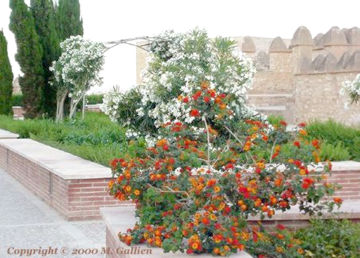
|
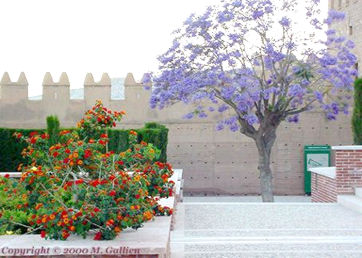
|
Inside the first level of the Alcazaba are some remarkable gardens. Now, the province of Almeria is very dry - it gets on average 7 days of rain a year - but there is no desert at the Alcazaba. The Moorish architecture includes many, many man-made streams and fountains of water. It literally flows in channels in the sidewalks. In some ways, it works as ancient air-conditioning, evaporating in the summer heat to cool the air. The water, circulated from a cistern, also was used to support agriculture for this walled city's inhabitants. Nowadays, it supports the life of lush gardens filled with jacaranda and olive trees, bushes, lantana and many varieties of roses.
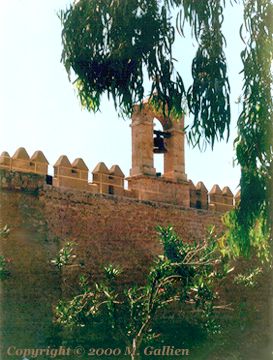
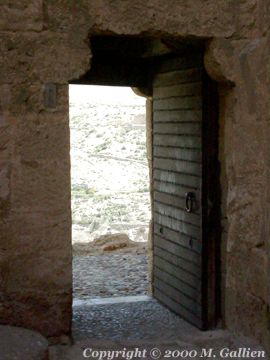
When Ferdinand's army conquered the Alcazaba, they had built a Christian church within its walls. This included the St. Mary's bell tower (photo at left), which is still tolled today. It is within the 2nd level of the Alcazaba, which includes the former living quarters of the Moorish rulers, their baths, and more gardens. The architecture of the place is fascinating, and because of its location on a hilltop, the views towards the Mediterranean and the desert (photo at right) are breathtaking.

The second level of the Alcazaba has not been well-preserved, but archaeologists are working on the site to get a better understanding of the lives of the Moors that inhabited Spain centuries ago. Amongst these ruins of baths and living quarters rises a 3rd level, which is the Armoury. It is within this area that the opening sequence for the Queen of Swords premiere episode, "Destiny", was filmed. One of the towers now contains 4 cannons and is called the "Powder Room." The acoustics of this room are quite interesting - every sound made in it resonates like a struck bell. I certainly feel sorry for anyone there when those cannons went off!


The series, Queen of Swords, was being filmed in Texas, Hollywood, which is right outside the small town of Tabernas. It was easy to see why it was chosen - the area does look much like southern California. This photo was taken on one of the plains used for shooting. This panoramic view was actually 7 photos - which gives you a good idea of how much vista without signs of modern life is present here.
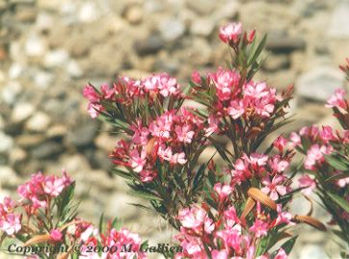
|

|
While much of the area is desert, it is not totally barren. Spain is the largest producer of olive oil in the world, and the province of Almeria is loaded with olive groves. The climate and the soil are perfect for them, as well as oleander, agave, and prickly pear. We were also fortunate enough to arrive there during the Spring. It is quite a wonder to behold the desert flora in full bloom. This colorful celebration of life, despite the harsh conditions, is created by the plants' biological imperative to reproduce. It is an amazing display of the power of Nature.

|
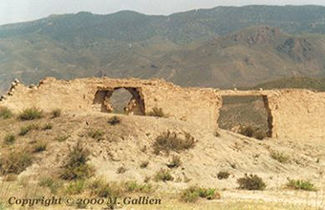
|
Every time we turned around, we found ruins in Spain.They are all over the place, especially in the desert regions. Some of them have historical significance, but time and neglect have taken their toll. Above the town of Tabernas, there are ruins of a castle that was inhabited by Ferdinand and Isabella in the 15th century, during their siege of Almeria (photo at left). We also found out that some were homesteads that had simply been abandoned. The Spanish government, in an effort to get these abandoned homesteads, many of which were under culivation when inhabited, productive again, are letting their citizens have them for free if they rebuild, live and farm them again. Can you imagine free land?! Others, like this one near the set (photo at right), are on commercial property and make for great scenery for film and television.


|

|
We affectionately refer to the view on the left as "our back yard." We arrived in Almeria after 24 hours of travel, and were transported to our new home in the inky blackness of night. Exhausted, we collapsed into bed and awoke early the next morning (the Saturday before Easter), opened our window, and beheld the most spectacular view. That was it - we were in love with the place! From our walled porch, we could see the houses further up the mountainside, including a 5-story place still under construction. This one, like many others in the enclave, has a domed tower that is covered with many glazed tiles that glow in the almost-relentless Almeria sunshine.
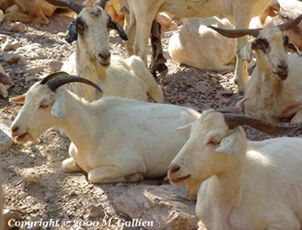
|

|
We lived on the side of a mountain in Sierra Cabrera, and as its name suggests, there were plenty goats in the area. There are two winding roads up to where we lived - one that leads directly to the highway, and a second, more serpentine one, that leads directly into Turre, the closest town. We referred to the latter as the "Thelma and Louise" route - one wrong move and you would fly down into the canyon. Along this road lived the "Goat Man," who would lead his herd out to graze in the morning, and lead them back to his home at sunset. When we arrived, the new batch of kids had arrived and were penned up. We watched them grow during the summer, butting heads with each other, scrambling over their feeders and climbing into the trees.
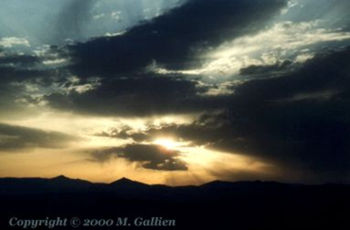
|
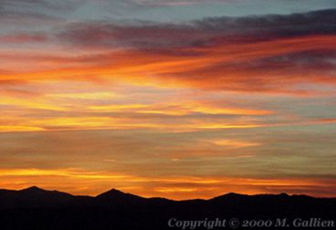
|
One of the great advantages of living out of the plastic cities was readily apparent - the place had absolutely georgous evening skies! Every evening we were home, we would watch the sky changing colors and textures as the sun set behind the moutains in the distance. These two photos are hardly a sampling of the sunset skies I photographed while we were there. Sierra Cabrera is truly a magical place!
�Copyright 2000 Mary Gallien. All contents, unless otherwise noted, are the property of Mary Gallien or used with permission of the copyright owner. All text and photos herein may not be reproduced or distributed without the express written consent of Mary Gallien, her official representative, or the copyright owner.
This page designed and maintained by Scorpio Rising. Send Comments